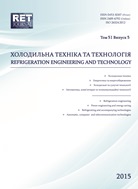EXPERIMENTAL WAY OF FIGURING OXYGEN EVAPORATION RATES IN ROCKET CYLINDRICAL TANK UNDER NATURAL CONDITIONS
DOI:
https://doi.org/10.15673/0453-8307.6/2015.56718Keywords:
The mass average gas temperature, boiling oxygen, temperature rods, partial pressure, hot helium, aerodynamic heat, oxygen evaporation speedAbstract
Study relates to rocket engine liquid oxygen fuel systems. The evaporation of oxygen was determined in ~5 long cylindrical tank. Experiments were taken under natural conditions. The tank was fuelled with boiling oxygen. The tank pressurization during flight was done with hot helium. It was input into tank as centralized jet with ~180 m/sec speed and mass average temperature ~500K. The total avg-integral aerodynamic heat flow into oxygen ~16 KWt/sq.m. The inner tank surface is waffled (mechanical milling). The gas temperature in free tank volume was measured in 25 spots using rods. The amount of free volume in tank was determined using fuel usage control system. The oxygen upper layer temperature inside the tank reaches the saturated vapour temperature by the middle of the flight when the absolute gas pressure is 1.3-1.5 bar. Oxygen evaporation insignificant speed was determined during engine working time (less than 1kg/sec). The correlation between evaporation speed and the value of aerodynamic heat flow was not determined. The likely reason is tank inner waffled surface and the presence of the power cone. The highest evaporation speed was measured in the beginning of the pressurization system functioning. The hot helium flow interacts with oxygen surface at that time. The necessity to decrease helium input speed was shown.References
Beliaev N.M. 1976. Sistemy nadduva toplivnykh bakov roket.- Moskva: Mashinostroenie/ - 336 (in Russian) 2. Degtiarev A.V., Kushcnarev A.P. 2014. Raketa kosmicheskogo naznacgeniia sverkhmalogo klasa. Kos-micheskaia tekhnika. Raketnoe vooruzhenie. Sb.nauch.-tekhn. st. GP «KB «Yuzhnoye». - №1.- s.14 – 20 (in Rus-sian). 3. Ring Elliot. 1964. Rocket Propellant and Pressuri-zaition Systems. – Prentice Hall., Inc., Englewood Cliffs, N.J. – 404 p. 4. Ametistov V.A., Pavlov Yu.M. Ametistov E.V. 1977. Kipenie kriogennikh zhidkostei. - Moskva: Energiia/ - 288 (in Russian) 5. Madejski I. 1972. Improved «three-component» theory of nuclear pool boiling. International Journal of Heat and Mass Transfer. – 1972. – vol.15, №3. – p. 503 – 512. 6. Hawitt H., Parker J. 1968. Bubble growth and collapse in Liquid Nitrogen. Trans. ASME, ser. C. – 1968, vol. 90, №1. – р. 22 – 26. 7. Forster K., Greif R. 1959. Heat transfer to a boiling liquid-mechanism and correlations. Trans. ASME, ser. C. – 1959. – v. 81. – p. 43 – 53. 8. Mitikov Yu. 2012. Rachetno-eksperimentalnye issledovaniia sverkhkholodnogo nadduva. Sistemne proek-tyvannia.-t.XIII. s.61-69. (in Russian). 9. Mitikov Yu., Voloshin M. 2015. Rezultatu fizicheskogo modelirovaniia progreva zhidkogo kisloroda v celendrichskom bake raketi-nositelia. Kholodilna tekhnika i tekhnologiia. –№51(4). – s.60 – 64 (in Russian)


